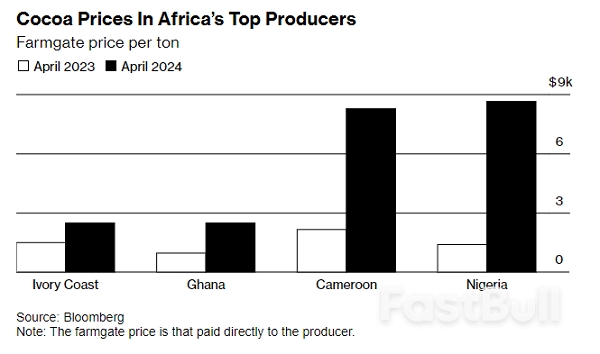In Cameroon, the astonishing surge in the price of cocoa has Banyuy Elsie Kinyuy planning the next chapter of her life. In November, the 57-year-old high school tutor bought a 3-hectare (7.4-acre) parcel of land about 200 kilometers (124 miles) northwest from her home in Yaoundé, the capital. The cocoa trees she’s planted there should begin bearing fruit by the time she retires in three years.
Laying the groundwork for Kinyuy’s career switch hasn’t come cheap. The traditional chief who sold her the plot also collected a fee of three goats, 40 liters (10.5 gallons) of palm wine and a bag of salt to grant her permission to farm the cash crop.
Kinyuy reckons the investment will pay off: “If the price of cocoa keeps rising, the crop will give me more money than teaching.”
Her story, and others like it heard by Bloomberg, shows how an unprecedented surge in the price of the key ingredient in chocolate is luring farmers in some parts of Africa back to the bean. The lag between the time it takes to plant and harvest a cocoa tree means the incipient trend won’t yield an instant fix for strained global supplies, but it could ease the squeeze down the line.
In the top two world producers, Ivory Coast and Ghana, cocoa farmers receive a price set by the government to ensure income predictability. But growers in Cameroon and Nigeria are free to sell to the highest bidder. And domestic cocoa prices in the two countries have more than tripled from a year earlier, spurred by a global shortage.

That’s what persuaded Jean-Marie Mbida Obam to hire two extra workers on his small farm in Cameroon and switch from growing plantains, groundnuts and cocoyams back to the cocoa he gave up on three years ago, when prices were lower.
“I remember earning 1.5 million CFA francs ($2,458) from these crops at one moment, whereas cocoa could barely give me 600,000 francs to 700,000 francs,” says the 61-year-old father of five. “I am back and prepared to completely revive all of my plantation. The cocoa price now is very good.”
Double-digit production declines in the Ivory Coast and Ghana—which between them account for more than 50% of global supply—have led to the scramble for beans. Cocoa farmers in those countries have been beset by bad weather and a shortage of fertilizer. This has propelled prices on the New York futures exchange to $10,000 a ton, from below $3,000 this time last year. And production isn’t expected to rebound soon.
Cocoa arriving at Ivory Coast ports from the start of the main harvest in October through March amounted to 1.3 million tons, about a third lower than a year earlier. Ghana’s output in the current season will total between 422,500 tons and 425,000 tons, half the country’s initial forecast, according to people familiar with the matter.
Forecasts by the International Cocoa Organization see Nigeria’s output falling 4% in 2023-24, to 270,000 tons, and Cameroon’s crop increasing 3% to 300,000 tons. By the end of the decade, Cameroon aims to raise production to 600,000 tons, while Nigeria projects a total of 714,000 tons by 2030.
John Kalu, a regional leader of growers in Nigeria’s Abia state, says there was a “long” list of prospective cocoa farmers trying to get in on the good times. The government has committed to leasing new land to farmers, but he says details are still vague.
In the meantime, scarcity is forcing grinders to pay big premiums to secure enough beans and avoid plant closures. These spreads range from $400 a ton in Ecuador and Peru to $2,500 in Ivory Coast, according to top cocoa processor Guan Chong Bhd., though Ivory Coast is trying to end the practice. A shortage of beans has also forced plants in Ghana to shut intermittently since late last year.
Growers in South America are also keen to expand production to cash in on cocoa’s high price. Ecuador, the world’s third-biggest producer, is targeting 800,000 tons by 2030, from 454,000 tons in 2023. Brazil, the No. 6 producer, plans to double volume by the end of the decade from 220,000 tons.
All those expansion plans could be curbed by European Union rules set to come into force at the end of this year. The EU will require chocolate makers such as Ferrero Group, Nestlé and Marsto to prove that every bean they import to the continent didn’t contribute to deforestation somewhere else.
Those who already have access to farmland may therefore have a leg up. In Nigeria’s Ondo state, retired civil servant Toba Adenowuro, 60, and his brother Timilehin, 43, who sells bread, sugar and other household essentials at a street stall, inherited a 5-hectare plot from their father last year. They recall how their father struggled to turn a profit from his cocoa crop during times of low prices. “All along we knew the payment to our father was not commensurate with farm yields and the rising prices of the commodity,” Adenowuro says.
Now the brothers are nursing 60,000 hybrid seedlings they expect to boost yields to 850 kilograms a hectare, from 400kg at present. Adenowuro says: “We want to rejuvenate the farm and to take a bite of the rising cocoa prices.”
Business News of Friday, 12 April 2024
Source: bloomberg.com













